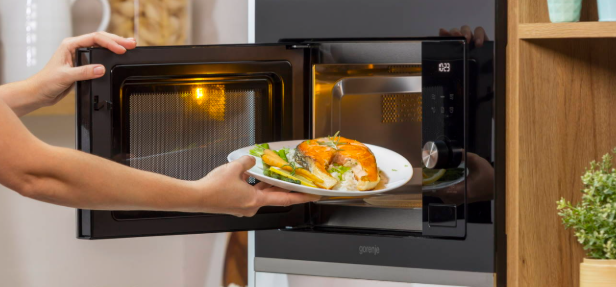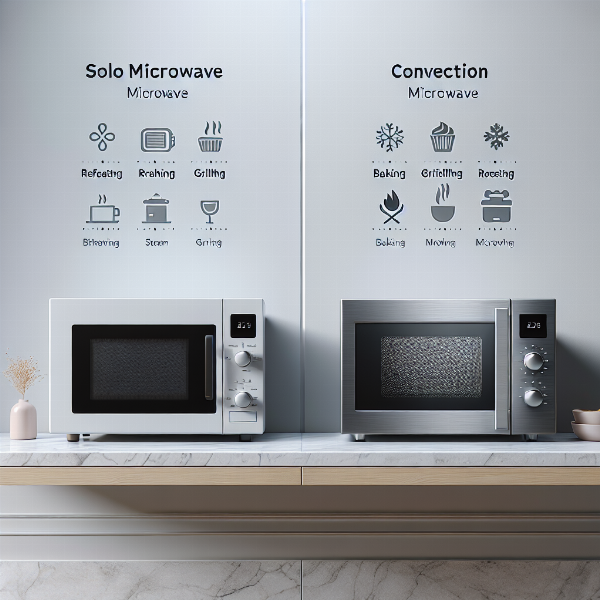Choosing between a solo and a convection microwave oven can be a bit like choosing between a bicycle and a scooter. Both get you where you need to go, but the journey and the capabilities are different. This article will delve into the key differences between these two popular kitchen appliances to help you make the best decision for your needs.
Understanding the Basics: Solo Microwave Ovens
Solo microwave ovens are the workhorses of the microwave world. They use magnetrons to generate electromagnetic waves that heat food quickly and efficiently. These microwaves primarily target water molecules in the food, causing them to vibrate and generate heat. This process makes solo microwaves ideal for reheating leftovers, defrosting frozen items, and quickly cooking simple dishes. Think of them as the go-to appliance for everyday convenience.
Advantages of Solo Microwaves
- Affordability: Solo microwaves are generally less expensive than their convection counterparts.
- Simplicity: They are easy to use, even for those unfamiliar with microwave technology.
- Energy Efficiency: Solo microwaves consume less energy than convection models, saving you money on your electricity bills.
- Compact Size: Perfect for smaller kitchens or limited counter space.
Taking it Up a Notch: Convection Microwave Ovens
Convection microwaves take the functionality of a solo microwave and add the power of convection cooking. They include a heating element and a fan that circulates hot air within the oven cavity, allowing for more even cooking and browning. This combination allows you to not only microwave but also bake, grill, and roast food, expanding your culinary possibilities.
Advantages of Convection Microwaves
- Versatility: Convection microwaves offer a wider range of cooking options compared to solo microwaves.
- Even Cooking: The circulating hot air ensures food is cooked evenly, eliminating hot and cold spots.
- Browning and Crisping: Convection cooking allows for browning and crisping, resulting in more appealing textures.
- Faster Cooking: Convection cooking can often be faster than traditional oven cooking.

A perfectly roasted golden-brown chicken being taken out of a modern convection microwave oven.
Solo vs Convection Microwave Oven: A Head-to-Head Comparison
| Feature | Solo Microwave | Convection Microwave |
|---|---|---|
| Cooking Method | Microwave radiation | Microwave + Convection heating |
| Functionality | Reheating, defrosting, simple cooking | Baking, grilling, roasting, microwaving |
| Cost | Lower | Higher |
| Energy Use | Lower | Higher |
| Cooking Speed | Fast | Faster (for some functions) |
| Crisping/Browning | No | Yes |
 A visual comparison of a basic solo microwave oven versus a versatile convection microwave oven.
A visual comparison of a basic solo microwave oven versus a versatile convection microwave oven.
Which Microwave Oven is Right for You?
Choosing the right microwave oven depends entirely on your individual needs and cooking habits. If you primarily use a microwave for reheating and basic cooking, a solo microwave is likely sufficient. However, if you’re looking for a more versatile appliance that can handle a wider range of cooking tasks, a convection microwave is worth the investment.
“For those who enjoy experimenting with different cooking techniques and want the flexibility to bake and roast in their microwave, a convection model is an excellent choice,” says culinary expert, Amelia Rodriguez.
Frequently Asked Questions
- Can you bake a cake in a solo microwave?
While some recipes exist for baking in a solo microwave, the results are often less than ideal. Convection microwaves are much better suited for baking. - Is a convection microwave worth the extra cost?
If you plan to use the convection features regularly, the added cost is justifiable. However, if you only need basic microwave functionality, a solo microwave is a more economical option. - Which type of microwave is easier to clean?
Both types of microwaves are generally easy to clean. However, convection microwaves may require slightly more effort due to the heating element and fan. - Can you use metal cookware in a convection microwave?
No, metal cookware should not be used in any type of microwave oven. - What is the lifespan of a microwave oven?
The average lifespan of a Microwave Oven is around 7-10 years. - Are convection microwaves more energy-efficient than conventional ovens?
Yes, convection microwaves are generally more energy-efficient than conventional ovens, especially for smaller cooking tasks. - What is the difference between a grill microwave and a convection microwave?
A grill microwave uses a heating element to grill food, while a convection microwave uses a heating element and fan to circulate hot air for baking and roasting. Some convection microwaves also include a grill function.
Making the Final Decision: Solo vs Convection Microwave Oven
“Ultimately, the best microwave for you depends on your cooking style and budget,” notes kitchen appliance specialist, David Chen.
Consider your needs carefully and choose the appliance that best fits your lifestyle. Whether you opt for the simplicity of a solo microwave or the versatility of a convection model, microwaveoventop.com is your one-stop resource for all things microwave related. We hope this comparison of Solo Vs Convection Microwave Ovens helps you make an informed choice.